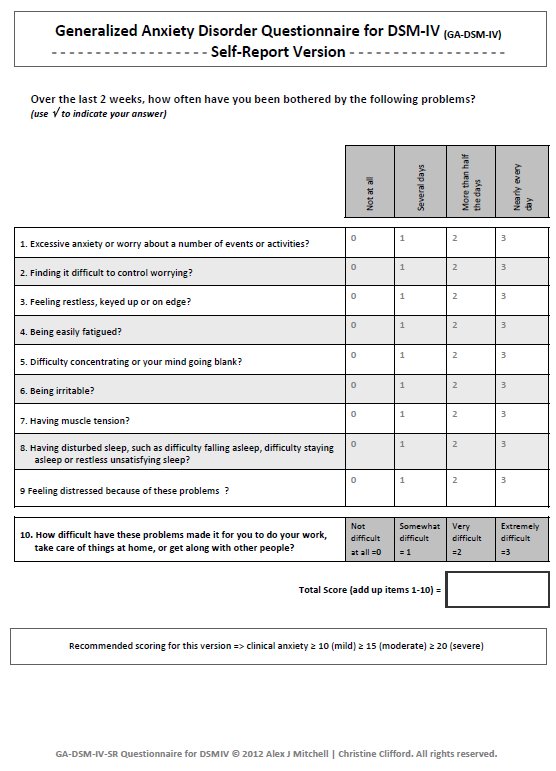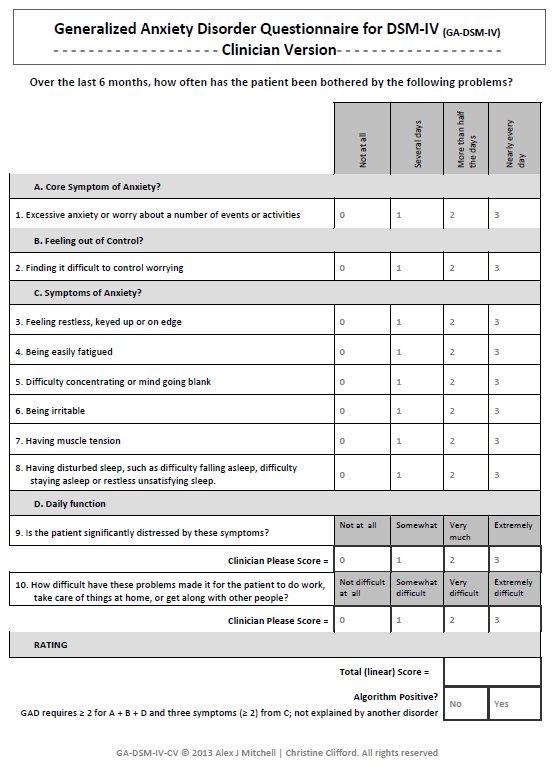|
www.anxietyscale.co.uk |
|||||
|
Generalized Anxiety Disorder Questionnaire for DSM-IV & DSM5 A rapid single page screening tool for detection of GAD in clinical practice by clinician or using patient self-report...royalty free during 2013
There are a large number of scales available which help clinicians assess, screen and diagnose anxiety disorders. Many of these have been only partially validated but most claim face validity by being compared with the diagnostic guidelines of DSM-IV | DSM5 (or ICD10). We recently looked in detail at 19 assessment scales of anxiety and in particular GAD. The scales themselves are listed below. Across all scales there was a very wide range of questions covering 44 domains. None seemed to offer a perfect fit with DSM-IV criteria (this includes GAD7). Further the time-frame of DSM-IV GAD is 6months, a very long period for self-reported recall of symptoms.
We therefore created a new scale GAD for DSM-IV & DSM5. This questionnaire has been designed to be fully aligned with the DSM-IV & DSM5 diagnostic criteria for generalized anxiety disorder using the exact wording used in the DSM-IV & DSM5 manual. It is available in two formats, a clinician version and a self-report version. The self-report version intentionally asks about the last 2 weeks whereas the clinician version follows the 6 month recommendation.
Epidemiology of Anxiety Disorders There has been accumulating work on anxiety disorders since 1980. Anxiety disorders are usually found to be the most common psychiatric disorders once subtypes are taken into account, more common than major depression (25% vs 17% point prevalence) (Kessler et al., 1994). Lifetime prevalence in the 1990’s US National comorbidity Survey (NCS) was about 20% for men, and 30% for women (Kessler et al., 1994). From DSMIII to DSMIIIR generalized anxiety disorder was considered a residual category after the exclusion of the other major anxiety disorders. DSM-III-R narrowed the definition further by requiring a minimum of six symptoms and a duration of six months. Using DSM-III-R criteria current GAD was 1.6% in NCS, 12-month prevalence was 3.1% and lifetime prevalence was 5.1% (Wittchen et al., 1994). Faravelli and colleagues (1989) found lifetime rates were 5.4% using DSMIIIR but 3.9% using DSMIII. If no hierarchical exclusions are applied then rates will be considerably higher. Overlap with other disorders is also an issue. In the NCS GAD was strongly associated with major depression, with 30-day GAD (OR 13.9), and lifetime GAD (OR 9.7) (Wittchen et al., 1994)
Both tools are designed to be simple to score whilst retaining accuracy and reliability. Strictly DSM-IV follows a set of rules or algorithm to diagnose GA. Clusters A+B+D must all be present as well as three symptoms from cluster C which in reality means 5 symptoms plus either disturbed function or distress (function and distress are cluster D see below). This would be equivalent to a linear (simple addition) score of 11 or higher (as "more than half the days" is a positive symptom). We consider clinically significant distress or dysfunction to be "very much distressed" on its own or "very impaired" on its own "somewhat distressed and somewhat impaired" in combination.
Royalty and Licensing The tool can be used clinically free of charge during 2013. A license is required for funded research, commercial use (click buy now below for a 250 application license). Permission is required for any reproduction, alteration or translation.
|
|||||
|
|
|||||
|
GAD QQ for DSM-IV/DSM5 Self Report Version
This is a self-report version of the GAD questionnaire for DSM-IV/DSM5 (GA-DSM-SR). This is designed to be given out to patients with minimal instruction. Patients should add up their scores for items 1-10 and can interpret their own scores according to the following: mild anxiety 11-15 moderate anxiety 16-20 and severe anxiety 21-30.
Tool Download and 250x Application License ($99)
Tool Image
Tool Download Royalty Free for 2013
Other Anxiety Scales In creating this scale, we also considered the following anxiety scales:
DASS 21 Anxiety Items only DASS All items The Kessler 10 GAD 7 HADS Beck Anxiety Inventory The Somatic and Psychological Health Report The Mental Health Inventory 5 The Brief Symptom Inventory The Profile of Mood States The General Health Questionnaire Anxiety items only The General Health Questionnaire All items The Mental Health Inventory 38 Anxiety items only The Mental Health Inventory 38 All items SCL-90-R Brief symptom inventory State-Trait Anxiety Inventory for Adults- State / Trait
The tool is subject to copyright (c) Alex J Mitchell / Christine Clifford but freely available (royalty free) for non-commercial and clinical use during 2013.
Current Research on the GA-DSMIV/DSM5 We welcome collaborations with other groups who are interested in using the GA-DSM for research.
|
GAD QQ for DSM-IV/DSM5 Clinician version
This is the clinician version of the GAD questionnaire for DSM-IV/DSM5 (GA-DSM-CV). This is designed to be used by clinicians who ask patients the listed questions (semi-structured questionnaire). Clinicians should use the algorithm method of scoring to decide upon caseness and the linear method to rate severity.
Tool Download and 250x Application License ($99)
Tool Image
Tool Download Royalty Free for 2013 |
||||
|
|
|||||
|
FAQ on the GA-DSMIV/DSM5
Q. Has the GA-DSM been validated? A. Not yet, we are planning a validation study at the current time Q. Can the GA-DSM be used clinically without permission? A. Yes, it is royalty free for clinical use during 2013 Q. Can the GA-DSM be used for research without permission? A. No, please write to me with the title and duration of your proposed project. It is likely I will grant permission. Q. What is the best cut off on the GA-DSM? A. We recommend the algorithm version where optimal accuracy is required; for the self-report version >10 is currently considered significant. Q. How long does the GA-DSM take to administer A. Usually about 1 - 3minutes Q. Has the GA-DSM been translated into.....my language? A. Probably not, please consider doing this and sending us your version Q. What should happen when someone scores above threshold? A. We recommend a further assessment for clinical anxiety along with a decision about appropriate treatment Q. How easy is it to adopt the GA-DSM into a screening programme? A. This should be straight forward as it is only 10 questions. Q. Can the GA-DSM be computerized to automated screening? A. Certainly, but no one has done this yet Q. Why the differing 6months and 2weeks in duration for each version? A. 6 months is the DSM rule but we feel this is too long for patient self-report Q. Can clinicians use a ultra-short version eg two items (Q1 and Q2) then if positive the remainder of the questions? A. Interesting idea, but this needs careful testing before recommendation.
References Wittchen HU, Zhao S, Kessler RC, Eaton WW (1994) DSM-III-R generalised anxiety disorder in the National Comorbidity Survey. Arch Gen Psychiatry 51: 355–364. Kessler RC, McGonagle KA, Zhao S, Nelson CB, Hughes M, Eshleman S, Wittchen HU, Kendler KS (1994) Lifetime and 12-month prevalence of DSM-III-R psychiatric disorders in the United States: Results from the National Comorbidity Survey. Arch Gen Psychiatry 51: 8–19. Faravelli C, Degl’Innocenti BG, Giardinelli L. 1989 : Epidemiology of anxiety disorders in Florence. Acta Psychiatr Scand 79:308_312.
|
|||||
|
|||||

